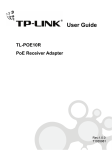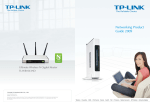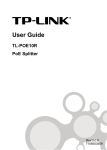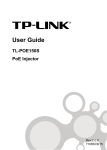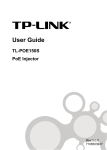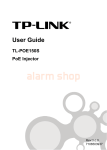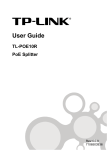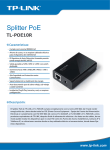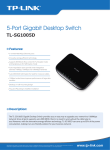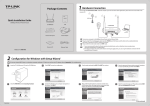Download TP-Link TL-POE150S V1 User Guide
Transcript
User Guide TL-POE150S PoE Supplier Adapter Rev:1.0.0 71035991 COPYRIGHT & TRADEMARKS Specifications are subject to change without notice. is a registered trademark of TP-LINK TECHNOLOGIES CO., LTD. Other brands and product names are trademarks or registered trademarks of their respective holders. No part of the specifications may be reproduced in any form or by any means or used to make any derivative such as translation, transformation, or adaptation without permission from TP-LINK TECHNOLOGIES CO., LTD. Copyright © 2008 TP-LINK TECHNOLOGIES CO., LTD. All rights reserved. http://www.tp-link.com FCC STATEMENT This equipment has been tested and found to comply with the limits for a Class B digital device, pursuant to part 15 of the FCC Rules. These limits are designed to provide reasonable protection against harmful interference in a residential installation. This equipment generates, uses and can radiate radio frequency energy and, if not installed and used in accordance with the instructions, may cause harmful interference to radio communications. However, there is no guarantee that interference will not occur in a particular installation. If this equipment does cause harmful interference to radio or television reception, which can be determined by turning the equipment off and on, the user is encouraged to try to correct the interference by one or more of the following measures: ¾ ¾ Reorient or relocate the receiving antenna. Increase the separation between the equipment and receiver. ¾ Connect the equipment into an outlet on a circuit different from that to which the receiver is connected. ¾ Consult the dealer or an experienced radio/ TV technician for help. This device complies with part 15 of the FCC Rules. Operation is subject to the following two conditions: 1) This device may not cause harmful interference. 2) This device must accept any interference received, including interference that may cause undesired operation. Any changes or modifications not expressly approved by the party responsible for compliance could void the user’s authority to operate the equipment. CE Mark Warning This is a class B product. In a domestic environment, this product may cause radio interference, in which case the user may be required to take adequate measures. CONTENTS Package Contents...........................................................................1 Chapter 1. Introduction ............................................................1 1.1 Overview of the production .......................................1 1.2 Features ....................................................................2 Chapter 2. Identifying External Components .........................2 Chapter 3. Connecting the PoE Supplier Adapter...................3 Appendix A: Specification ..............................................................6 Package Contents The following items should be found in your package: ¾ TL-POE150S PoE Supplier Adapter ¾ One Power Adapter ¾ One Power Cable ¾ One Ethernet (CAT5 UTP) Cable ¾ This User Guide ) Note: Make sure that the package contains the above items. If any of the listed items are damaged or missing, please contact with your distributor. Chapter 1. Introduction 1.1 Overview of the production Thank you for choosing the TL-POE150S PoE Supplier Adapter. The Power over Ethernet (PoE*) Supplier Adapter is able to supply steady power to Powered Device (PD*) or PoE Receiver Adapter over the Ethernet cable. The Ethernet equipment can work as a Power Sourcing Equipment (PSE*) with the help of the TL-POE150S connection. PoE technology allows the existing Ethernet infrastructure to transmit electrical power, along with data, to remote IP endpoints over the Ethernet cables, which can greatly save the cost of the external power cables. Your network can benefit from PoE 1 technology for it will ensure the normal working status of your network while keep the existing Ethernet infrastructure secure. *PoE: This technology describes a system to transmit electrical power, along with data, to remote devices over standard twisted-pair cable in an Ethernet network. *PD: a device powered by a PSE and thus consumes energy. Examples include powering IP telephones, wireless LAN access points, network cameras, network hubs, embedded computers etc. *PSE: a device (switch or hub for instance) that will provide power in a PoE setup. 1.2 Features ¾ Complies with IEEE 802.3, IEEE 802.3u, IEEE 802.3af standards ¾ Compatible with PoE compliant PDs and PoE Receiver Adapters ¾ Transmits electrical power along with data in one single cable ¾ External 48V DC power supply ¾ Supports Plug-and-Play for the devices, without any configuration ¾ Elegant appearance with space-saving mini size Chapter 2. Identifying External Components POWER+DATA OUT: Connect to the PD or PoE Receiver Adapter with a CAT5 UTP cable. 2 DC 48V: Connect to the provided power adapter which can supply steady power of 48V DC. LAN IN: Connect to a network device (such as a Switch or Router ) with CAT5 UTP cable. PWR: Power LED, a steady green light indicates that the PoE system has detected the PD or PoE Receiver Adapter and the power adapter is working properly. Chapter 3. Connecting the PoE Supplier Adapter You can use TL-POE150S PoE Supplier Adapter with PD or PoE Receiver Adapter to expand your network to where there are no power lines or outlets, where you wish to fix devices such as APs, IP Cameras or IP Phones, etc. The following steps will tell you how to connect the PoE Supplier Adapter correctly. 1. Use a CAT5 UTP cable to connect port of Ethernet device (such as a switch, hub or router) to the LAN IN port. 2. Please connect the power adapter properly to a power socket with provided power cable, and then connect the other end of the power adapter to the DC 48V port of the TL-POE150S. 3 3. Connect the POWER+DATA OUT port of the TL-POE150S to a PD or a PoE Receiver Adapter with CAT 5 UTP cable. Now, the device can work normally with data and power. There are two schemes to realize the PoE. 1. If the device supports PoE (take an IP camera with PoE for example), following topology will work: CAT5 UTP Cable (Data) Switch TL-SF1008D Power Adapter Power Cable (Power) TL-POE150S IP camera with PoE CAT5 UTP Cable (Power & Data) ` 2. PC If the device does not support PoE, it is necessary to have a PoE Receiver Adapter to separate the power and data, transmitting them detached in one UTP cable and one power cable. Here we take TP-LINK TL-POE10R Receiver Adapter for example. You can use following topology: 4 Power Adapter Notebook With Wireless Adapter Power Cable (Power) CAT5 UTP Cable (Data) TL-POE150S CAT5 UTP Cable TL-POE10R (Power & Data) Power Cable CAT5 UTP Cable Switch TL-SF1008D (Data) Wireless AP TL-WA601G ) Note: ¾ Do not mistake the power port of the TL-POE150S and TL-POE10R when choosing the scheme 2, or else it will cause serious damage to your network device. ¾ If you want to know more details about TL-POE10R Receiver Adapter, please refer to “TL-POE10R User Guide” on our website http://www.tp-link.com. 5 Appendix A: Specification Normal Standards IEEE 802.3, IEEE 802.3u, IEEE 802.3af Power Output 15.4W (48V DC) Ports PoE Port 100BASE-TX / 10BASE-T dual purpose LAN Port port Cabling Type RJ45 CAT 5 UTP cable LED PWR Safety & Emissions FCC, CE Environmental and Physical Operating Temp. 0℃~40℃ (32℉~104℉) Storage Temp. -40℃~70℃ (-40℉~158℉) Operating Humidity 10%~90% RH, Non-condensing Storage Humidity 5%~90% RH, Non-condensing 6












